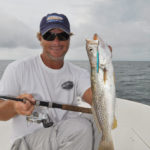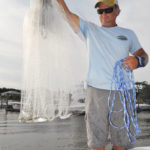
Flounder and gray trout make a summer fishing trip to nearshore structure out of Wrightsville Beach of Carolina Beach a good idea.
Rennie Clark piloted his boat out of North Carolina’s Masonboro Inlet, nosing the bow through the rolling waves. Clouds in the overcast sky threatened rain, but the wind was calmly whispering out of the southwest, which made the seas nearly flat.
“If we can catch a break with the weather, we can also catch some nice fish on the reefs and ledges,” he said. “The flounder and gray trout have been biting.”
Clark, 42, who operates Tournament Trail Charters, has been guiding for a number of different species between Topsail Beach, N.C., and Southport, N.C., over the past 10 years, while fishing in a dozen redfish tournaments on several trails every year.
“During the summer, the fish really congregate on the nearshore structure just off the beaches,” he said. “The artificial reefs fill up with flounder and gray trout and they can fill up with anglers, too. The best bet is fishing during the week when the waters are not as crowded. The other thing you can do is find the little rocks and lesser-known wrecks away from the larger artificial-reef structure marked on maps. You can have those places all to yourself.”
For whatever reason, when Clark reached the destination he had plotted in his GPS unit, no other boats were in the area.
Before leaving the Intracoastal Waterway, Clark uses a cast net to fill his livewell with finger mullet. He may hit Masonboro Inlet’s rock jetties or sandbars around Carolina Beach Inlet with a few casts for red drum using Carolina rigs baited with mullet. Then, he heads out to fish the ledges and reefs.
It didn’t take Clark long to find the right spot. Hovering over the baitfish and hard structure he could see on his depth finder’s screen, he dropped a mullet to the bottom on a Carolina rig. In a few moments, a flounder struck, and he reeled the fish to the boat and landed it with a net. After his initial success, however, the bait stealers moved in, making short work of the live baits intended for flounder.
“Pinfish, croakers, pigfish, toadfish and sharks can swarm the structure when the water heats up,” he said. “You have three choices. You can continue to feed the fish until the right one comes along, which empties your livewell quickly. You can move, or you can switch to an artificial lure. I prefer to try a jigging spoon.”
Clark says a jigging spoon is much more durable than a jighead fished with an artificial trailer or with a live minnow impaled on its hook. That many small mouths can nibble away the dressing of a jig or added soft trailers, but they won’t harm a metal spoon.
“I use Stingsilvers or other heavy spoons,” he said. “One thing I do improve them is remove the treble hook. I replace the treble with a single VMC circle hook of the appropriate size. The chemically sharpened hook will catch anything that gets near it, and with its larger bend, it digs farther back into a fish’s mouth without tearing out. That is especially important if you are after gray trout. In summer, the reefs and ledges are full of them.”
Clark said that the one-fish creel limit for gray trout is hardly enough incentive for anglers to plan an outside-the-inlet trip, but two anglers with two of the nice gray trout usually available will have the ice in their cooler covered up before any flounder comes onboard.
“The gray trout have been getting bigger over the years since the creel limit fell to one fish,” he said. “Two-pounders are common and it is not unusual to catch one that weighs 4 to 6 pounds.”
Clark dropped the spoon, letting it free-fall until the instant it hit the bottom. Then, he immediately turned his reel handle two or three times.
“If you try to bump it up and down hitting the bottom every time, you are going to hang up a lot of spoons and break them off,” he said. “That can get expensive, and you can also run out of your favorite colors if you only have a few of them along. Flounder will come up off the bottom several feet to strike a spoon. If you look at your depth finder, you can usually spot gray trout or the baitfish they are feeding on, and they may be quite a distance off the bottom.”
DESTINATION INFORMATION
HOW TO GET THERE — The Wrightsville Beach/Carolina Beach area is reached from most places in North Carolin through WIlmington, via I-40, US 421 or US 17. Popular public boat ramps are at the base of the US 74 bridge across the ICW in Wrightsville Beach, and at Snow’s Cut off US 421 at Carolina Beach. For a list of artificial reefs, visit http://portal.ncdenr.org/web/mf/artificial-reefs-program.
WHEN TO GO — June, July and August are prime months to catch flounder and gray trout on nearshore structure.
BEST TECHNIQUES — Live bait and jigs are the most-productive lures for flounder and gray trout around nearshore wrecks and reefs. Stingsilvers are particularly productive in blue/white, blue/silver and pink. Go with 7-foot, medium-action spinning rods mated with reels spooled with 50-pound braid.
FISHING INFO/GUIDES — Rennie Clark, Tournament Trail Charters, 910-465-8943. See also Guides & Charters in Classifieds.
ACCOMMODATIONS — Sleep Inn, Wilmington, 910-313-6665; Pleasure Island Chamber of Commerce, www.pleasureislandchambernc.org.
MAPS — Maps Unique, 910-458-9923, www.mapsunique.com; GMCO Maps, GMCO’s Chartbook of North Carolina, 888-420-6277, www.gmcomaps.com.







Be the first to comment